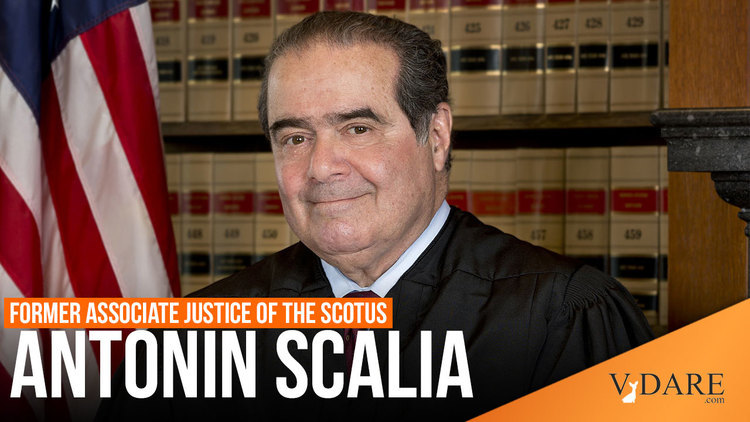![]() In Scalia's Court: A Legacy of Landmark Opinions and Dissents, author Kevin Ring writes
In Scalia's Court: A Legacy of Landmark Opinions and Dissents, author Kevin Ring writes
When Justice Scalia joined the Supreme Court in 1986, the Court had held that legislative classifications designed to overcome past racial discrimination by favoring minorities were permissible and not subject to strict scrutiny under the Equal Protection Clause. The prevailing wisdom was that Congress and the states had the authority to take concrete steps to rectify any inequities caused by racial prejudice and bigotry. In short, they were free to try to “level the playing field.”
But Justice Scalia argued
that the Equal Protection Clause applied to individuals and therefore government could not unfairly discriminate against any individual in order to give an advantage to another individual who was a member of a group that had been historically disadvantaged. His opinions on race were brief but eloquent.
Ring gives as an example Scalia's opinion in City of Richmond v. J. A. Croson Co., (1989) in which Scalia referred Richmond's minority-favoring contracting program as the
"enactment of a set-aside clearly and directly beneficial to the dominant political group, which happens also to be the dominant racial group. The same thing has no doubt happened before in other cities (though the racial basis of the preference has rarely been made textually explicit)—and blacks have often been on the receiving end of the injustice. Where injustice is the game, however, turnabout is not fair play."
![Levar Stoney.jpg]() Scalia's point here was that the city of Richmond, VA had been, since 1977, under black rule, an event that the Richmond Times-Dispatch referred to as the "1977 power shift" in a 2015 article.
Scalia's point here was that the city of Richmond, VA had been, since 1977, under black rule, an event that the Richmond Times-Dispatch referred to as the "1977 power shift" in a 2015 article.
Wikipedia explains that
In 1977, a federal district court ruled in favor of Curtis Holt Jr. who had claimed the council's existing election process—an at large voting system—was racially biased. The verdict required the city to rebuild its council into nine distinct wards. Within the year the city council switched from majority white to majority black, reflecting the city's populace. This new city council elected Richmond's first black mayor, Henry L. Marsh.
(Pictured right, the current Mayor, Levar Stoney.)
What that means is that while, as Steve Sailer says, liberals always seem to think that America is "Clarksdale, Mississippi in 1965", in fact many places in South are run by blacks. Black rule in Richmond has produced a number of results that it would have been racist to predict. [List of Richmond-area elected officials previously indicted, by Alix Bryan and Sandra Jones, WTVR, September 5, 2014] Not everyone on that list is black, but this sex offender was,and so was this drug addict, and this Federally-indicted influence peddler, and this fraudster.
But scheme created by Richmond's black officials to reserve city contracting business to their black brothers and sisters wasn't technically corrupt or illegal. Since they were the government, it was the law, at least locally.
It was, however, as Scalia pointed out, as unconstitutional as any similar scheme by whites for whites would be, and it was not, obviously, being done in the interest of reparative justice (i. e. "white guilt") but rather as an ethnic spoils system.
How much of affirmative action is done on this “For Us, By Us” basis?




 In
In  Scalia's point here was that the city of Richmond, VA had been, since 1977, under
Scalia's point here was that the city of Richmond, VA had been, since 1977, under 








